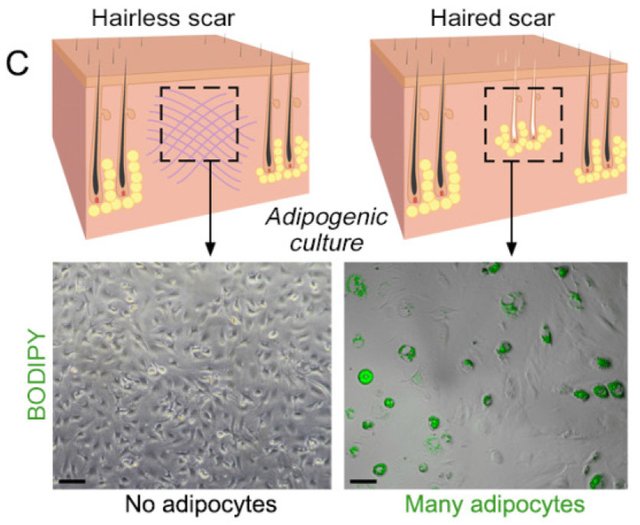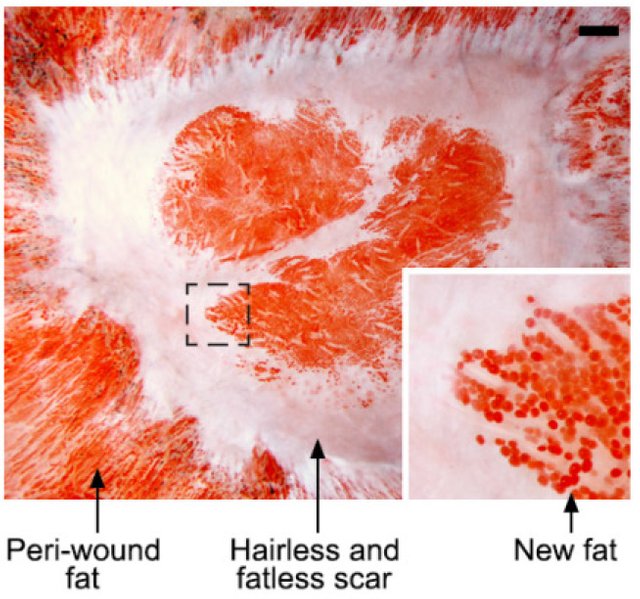Healing Wounds without Scarring
A new method of transforming common cells into fat cells enables wounds to heal and regenerate skin, rather than scar tissue.

source
It was previously thought impossible to transform normal types of cells into fat cells, but research to do just that began at the Perelman School of Medicine. This led to a multi-year connected study with the Plikus Laboratory for Developmental and Regenerative Biology, which has been recently published in the journal Science, on January 5th.
A type of fat so-called adipocytes are normally found in the skin but are lost when a wound heals as a scar.
Scar tissue doesn't have any hair follicles which makes it different from the rest of the skin, and this is formed with myofibroblasts cells during wound healing. Researchers managed to change these myofibroblasts cells into fat cells that would not cause scarring during healing.
"Essentially, we can manipulate wound healing so that it leads to skin regeneration rather than scarring"
The secret to the success, according to Dr. George Cotsarelis, is to regenerate the hair follicles first to which the fat regenerates in response to signals from those hair follicles.

source
Hair and fat develop separately, but not independently. Hair follicles come first, enter is a change in surrounding myofibroblasts to regenerate as fat. The fat doesn't form without new hair, but once it does the new cells are indistinguishable from pre-existing fat cells.
The new growth factor was identified in examining the signals from the hair to the fat cells, called Bone Morphogenetic Protein (BMP). This tells the myofibroblasts to become fat.
Prior to this research it was thought impossible for myofibroblasts to become a different type of cell. This research shows that the cells can be influenced to become adipocytes. It was demonstrated both in mouse and human keloid cells grown in culture.

source
This research has potential to revolutionize dermatology and corrective surgery aesthetics. Increase in fat cells and tissue can help more than just wounds. The loss of adipocyte cells is common in other conditions such as the treatment for HIV. The cells are also lost naturally in the aging process, especially the face which leads to permanent deep wrinkles. This new research could help to fend off the effects of aging.
"Our findings can potentially move us toward a new strategy to regenerate adipocytes in wrinkled skin, which could lead us to brand new anti-aging treatments," Cotsarelis said.
Both research institutions and now focusing on separate avenues. Cotsarelis Lab is looking at the mechanism that promotes skin regeneration, while Plikus Laboratory is focusing on the reprogramming of cells and healing wounds.
References:
- Using fat to help wounds heal without scars
- Regeneration of fat cells from myofibroblasts during wound healing
If you appreciate and value the content, please consider:
@krnel
2017-01-07, 11:56am

Wow, great article. I've learn quite a bit in there, especially the jargon itself. Thanks for sharing and educating me. Namaste :)
great article!something which is worth reading!
Hi @krnel
Very interesting and informative article, thanks.
Hair and fat develop separately...not "Heron fat" You confused the hell out of me! I'm thinking heron's don't have hair...Great article though!
Hehe sorry. I have carpel tunnel and try to use speech to text sometimes, and it doesn't work perfectly, and I sometimes miss it in editing, thanks for the catch.